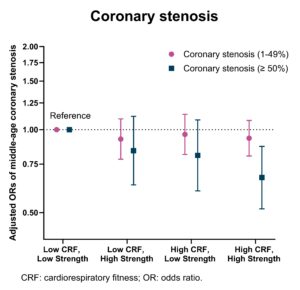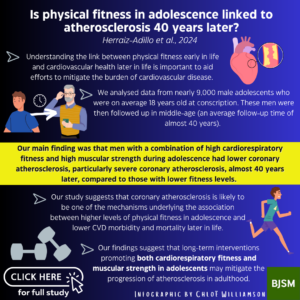Authors: Ángel Herraiz-Adillo, Viktor H. Ahlqvist, Sara Higueras-Fresnillo, Kristofer Hedman, Emil Hagström, Melony de Fortuin-de Smidt, Bledar Daka, Cecilia Lenander, Daniel Berglind, Carl Johan Östgren, Karin Rådholm, Francisco B. Ortega, and Pontus Henriksson.
In our recent work published in the British Journal of Sports Medicine (1), we show an association between adequate physical fitness during adolescence and lower levels of coronary atherosclerosis in middle-age.
Why is this study important?
Understanding the link between physical fitness early in life and later cardiovascular health later in life is important to aid efforts to mitigate the burden of cardiovascular disease (CVD). Physical fitness, which includes factors like cardiorespiratory fitness and muscular strength, has consistently been found to be associated with CVD and mortality. However, the exact mechanisms behind this relationship remain unclear.
Atherosclerosis, characteriszed by the buildup of plaque within arteries, is recognized as a leading cause of CVD. Developing over decades with a prolonged asymptomatic phase, atherosclerosis presents a window of opportunity to modify its course, potentially reducing global rates of CVD and mortality. Despite the acknowledged importance of investigating the relationship between physical fitness and atherosclerosis, prior studies have primarily relied on the coronary artery calcium (CAC) score, which provides an incomplete picture by only assessing calcified plaques.
Our study overcomes this limitation by utilizing Coronary Computed Tomography Angiography (CCTA), a more comprehensive imaging modality that enables the examination of both calcified and non-calcified plaques. This is important since non-calcified plaques are more prone to rupture, leading to heart attacks and implying a worse prognosis. Furthermore, we investigated both coronary and carotid plaques, allowing for a broader understanding of the atherosclerotic burden across different arterial regions.
How did the study go about this?
We analysed data from nearly 9,000 male adolescents who were on average 18 years old at conscription. These men were then followed up in middle-age (an average follow-up time of almost 40 years). Cardiorespiratory fitness at conscription was assessed with a maximal cycle-ergometer test, while muscular strength was evaluated through maximal knee extension, handgrip, and elbow flexion strength. Coronary atherosclerosis in middle-age was assessed using CCTA, providing information on the 18 coronary segments and categorized as follows: no stenosis, < 50% (mild) stenosis, and ≥ 50% (severe) stenosis. Coronary atherosclerosis was also examined using CAC, which yielded a quantitative CAC score. Finally, carotid atherosclerosis was evaluated using ultrasonography, and categorized as no plaque, unilateral plaque/s, and bilateral plaques.
What did the study find?
Our main finding was that men with a combination of high cardiorespiratory fitness and high muscular strength during adolescence had lower coronary atherosclerosis, particularly severe coronary atherosclerosis, almost 40 years later, compared to those with lower fitness levels. However, our study did not find clear associations between physical fitness and carotid atherosclerosis.

What are the key take-home points?
Our study suggests that coronary atherosclerosis is likely to be one of the mechanisms underlying the association between higher levels of physical fitness in adolescence and lower CVD morbidity and mortality later in life. Although further studies are warranted, our findings suggest that long-term interventions promoting both cardiorespiratory fitness and muscular strength in adolescents may mitigate the progression of atherosclerosis in adulthood.
References
- Herraiz-Adillo Á, Ahlqvist VH, Higueras-Fresnillo S, Hedman K, Hagström E, Fortuin-de Smidt M, Daka B, Lenander C, Berglind D, Östgren CJ, Rådholm K, Ortega FB, Henriksson P. Physical fitness in male adolescents and atherosclerosis in middle-age: a population-based cohort study. Br J Sports Med. 2024 Feb 14:bjsports-2023-107663. doi: 10.1136/bjsports-2023-107663. Epub ahead of print.
